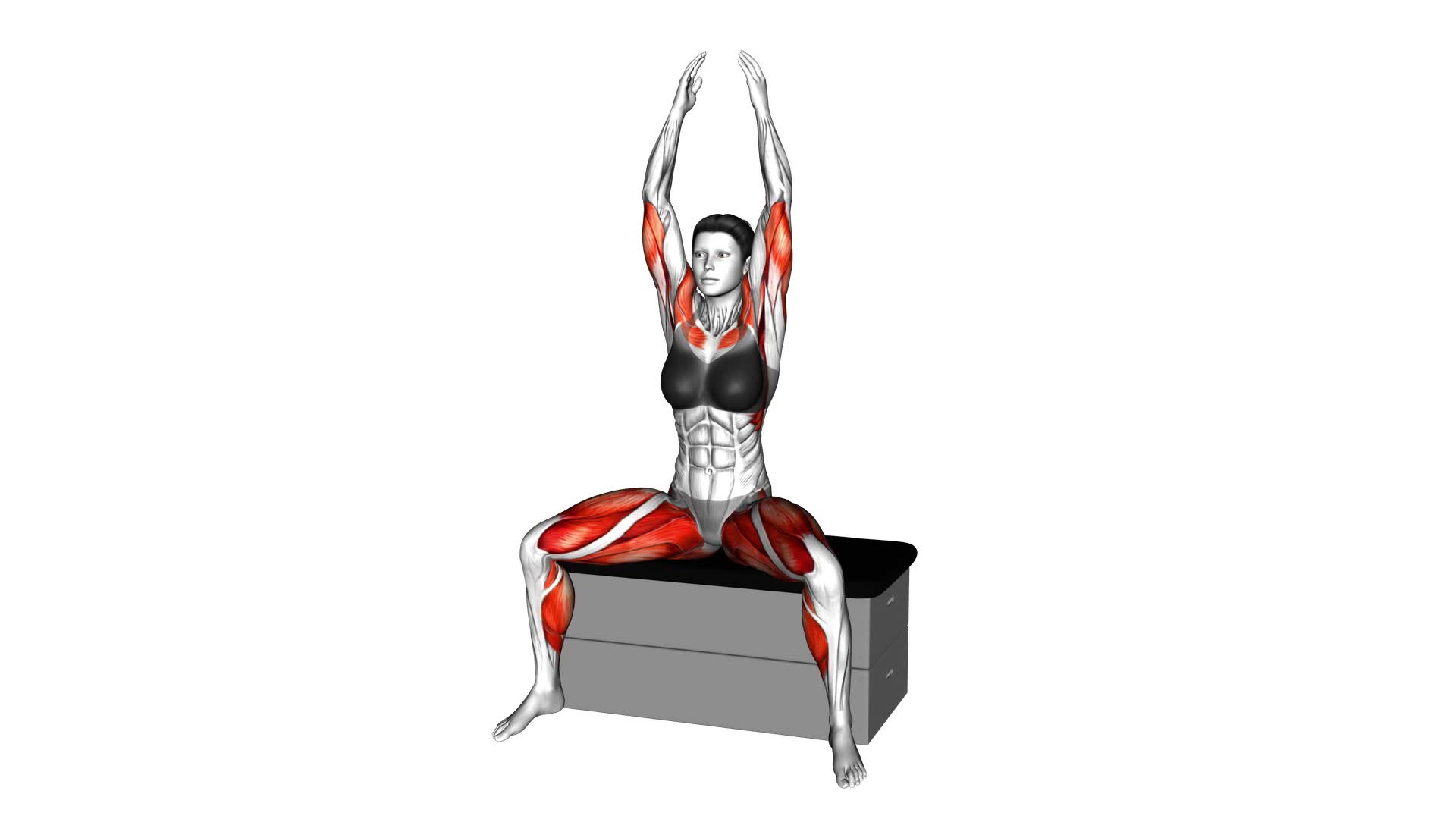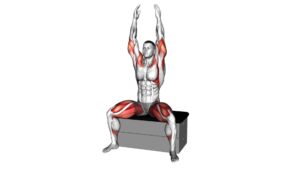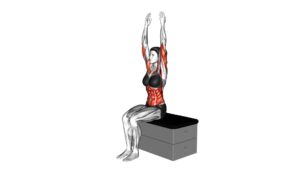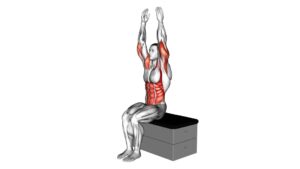Sitting Shoulder Press and Hip Abduction on a Padded Stool (Female) – Video Exercise Guide & Tips

In this video exercise guide, you'll learn how to properly perform sitting shoulder press and hip abduction on a padded stool. These exercises are specifically designed for females looking to strengthen their upper body and lower body muscles.
Watch This Exercise Video
By following the tips and techniques provided, you can increase resistance and progress in your fitness journey. Additionally, we'll discuss common mistakes to avoid and important safety precautions to keep in mind while performing these exercises.
Let's get started!
Key Takeaways
- Sitting shoulder press and hip abduction target multiple muscle groups simultaneously, including the shoulders, triceps, upper back, and hip abductors.
- These exercises help improve overall upper body strength, posture, and hip strength and stability.
- Proper form is crucial for both exercises, including sitting with feet flat on the ground and back straight, holding dumbbells at shoulder level with palms facing forward, and maintaining a slight bend in the knee during hip abduction.
- To increase resistance and progression, incorporate progressive overload techniques such as gradually increasing weight or resistance, adjusting repetitions and sets, trying exercise variations, and challenging the muscles consistently.
Benefits of Sitting Shoulder Press
To maximize the benefits of your sitting shoulder press exercise, it's important to understand how it can help you achieve increased strength and improved posture in your upper body.
The sitting shoulder press is a powerful exercise that targets your shoulder muscles, specifically the deltoids, as well as your triceps and upper back muscles. By regularly incorporating this exercise into your fitness routine, you can develop stronger and more defined shoulders, which won't only enhance your overall upper body strength but also improve your posture.
The sitting shoulder press works by requiring you to push weights or resistance bands overhead while seated. This movement engages your deltoid muscles, causing them to contract and strengthen. As you increase the weight or resistance over time, your muscles adapt and grow stronger, leading to increased strength in your shoulders. Additionally, the sitting position helps stabilize your body, allowing you to focus solely on your upper body muscles without the need for stabilization from your core.
In terms of improved posture, the sitting shoulder press targets the muscles in your upper back that are responsible for maintaining proper alignment. As these muscles strengthen, they can help pull your shoulders back and down, promoting a more upright posture. This can have a positive impact on your overall appearance and can also alleviate any discomfort or pain caused by poor posture.
Proper Form for Shoulder Press on a Padded Stool
When performing the sitting shoulder press on a padded stool, it's important to maintain proper form and alignment to maximize the effectiveness of the exercise. Here are some key tips to ensure you're performing the shoulder press technique correctly:
- Sit on the padded stool with your feet flat on the ground and your back straight against the backrest.
- Hold a dumbbell in each hand, positioning them at shoulder level with your palms facing forward.
- Engage your core and press the dumbbells upward, extending your arms fully without locking your elbows.
- Lower the dumbbells back down to shoulder level in a controlled manner.
Proper form is crucial to prevent injuries and target the shoulder muscles effectively. By following these guidelines, you can maintain the correct alignment and engage the targeted muscles during the exercise.
Additionally, performing the shoulder press on a padded stool offers specific benefits, including hip abduction benefits. This exercise requires stability in the hips and engages the muscles responsible for hip abduction, helping improve hip strength and stability.
By incorporating hip abduction into the shoulder press, you can work multiple muscle groups simultaneously, enhancing overall strength and stability in the upper and lower body.
Tips for Increasing Resistance and Progression
To increase resistance and progress in your sitting shoulder press and hip abduction exercises, there are a few key points to keep in mind.
First, incorporate progressive overload techniques by gradually increasing the weight or resistance you use.
Second, try using resistance bands to add variety and challenge to your workouts.
Finally, make proper form adjustments as needed to ensure you're targeting the right muscles and maximizing your results.
Progressive Overload Techniques
As you engage in the Sitting Shoulder Press and Hip Abduction on a Padded Stool exercise, it's important to utilize progressive overload techniques to effectively increase resistance and progression. Progressive overload refers to gradually increasing the demands placed on your muscles over time, which is key to achieving continuous improvements in strength and muscle growth.
Here are three tips to help you incorporate progressive overload into your workout routine:
- Increase the weight: Gradually increase the amount of weight you lift during the exercise. This will challenge your muscles and stimulate further adaptation.
- Adjust the repetitions and sets: Increase the number of repetitions or sets you perform for each exercise. This can help to increase the overall volume of your workout and promote muscle growth.
- Try exercise variations: Incorporate different exercise variations that target the same muscle groups. This can provide a new stimulus and prevent plateaus in your progress.
By implementing these progressive overload techniques, you can ensure that you continue to challenge your muscles and make consistent progress.
Now, let's move on to exploring resistance band variations to further enhance your workout.
Resistance Band Variations
To enhance the resistance and progression of your workout, incorporate resistance band variations.
Resistance bands are a versatile tool that can be modified to increase the level of difficulty for advanced hip abduction exercises. By using thicker bands or doubling up on bands, you can add more resistance to target the muscles in your hips and glutes more effectively.
Another modification is to anchor the band higher or lower to change the angle of resistance. This can provide a different challenge and engage different muscle fibers.
Additionally, you can incorporate dynamic movements such as lateral walks or standing hip abductions with the band, which adds an element of instability and further challenges your muscles.
Proper Form Adjustments
You can increase resistance and progression in your workouts by making proper form adjustments. By ensuring that you have the correct form, you not only maximize the effectiveness of the exercise but also minimize the risk of injury.
Here are some tips for making proper form adjustments:
- Maintain a neutral spine: Avoid arching your back or rounding your shoulders. Keep your spine aligned from your head to your tailbone.
- Engage your core: Activate your abdominal muscles throughout the exercise to stabilize your torso and prevent excessive swaying or leaning.
- Use the appropriate weight: Choose a weight that challenges you but still allows you to maintain proper form. Avoid using weights that are too heavy and compromise your technique.
Hip Abduction Technique for Females
To perform proper hip abduction, keep your back straight, engage your core, and lift your leg out to the side while maintaining control and stability.
This exercise targets the muscles of the outer thighs and glutes, helping to strengthen and tone them.
Hip abduction can also improve hip stability and mobility, making it a beneficial exercise for females looking to enhance their lower body strength and function.
Proper Hip Abduction Form
Achieve proper form for hip abduction by maintaining a slight bend in your knee throughout the exercise. This will help target and engage the hip muscles effectively. Here are some tips to ensure you have the correct form:
- Sit upright on a padded stool with your feet flat on the floor.
- Place a resistance band around your thighs, just above your knees.
- Slowly and controlled, lift one leg out to the side, keeping the knee slightly bent.
- Pause for a moment at the top of the movement, then lower your leg back down.
- Repeat the exercise for the desired number of repetitions on each leg.
By maintaining proper form during hip abduction exercises, you can effectively strengthen your hip muscles and improve stability.
Now, let's move on to the benefits of hip abduction.
Benefits of Hip Abduction
By incorporating hip abduction exercises into your workout routine, you can experience a multitude of benefits.
Hip abduction, which involves moving your leg away from your body's midline, targets the muscles in your outer thighs and hips.
One of the primary benefits of hip abduction is strengthening these muscles, which can improve your overall lower body stability and balance.
Additionally, hip abduction exercises can help to tone and shape your hips, thighs, and buttocks, making them a great addition to any lower body sculpting routine.
There are various variations of hip abduction exercises, including using resistance bands, weight machines, or bodyweight exercises. These variations allow you to target different muscles and add variety to your workout routine.
Common Mistakes to Avoid During Hip Abduction
One common mistake to avoid during hip abduction is leaning too far forward. This can compromise the effectiveness of the exercise and put unnecessary strain on your lower back.
To ensure proper form and maximize the benefits of hip abduction, here are some important adjustments to keep in mind:
- Maintain an upright posture: Keep your spine straight and engage your core muscles to support your back. Avoid rounding your shoulders or slouching forward.
- Avoid using momentum: It's crucial to perform hip abduction with controlled movements. Avoid swinging your legs or using momentum to lift them. Instead, focus on using the targeted muscles to initiate the movement.
- Use a suitable resistance level: Using too much or too little resistance can hinder your progress and potentially lead to injury. Choose a resistance level that challenges you but still allows you to perform the exercise with proper form.
Safety Precautions and Modifications for Padded Stool Exercises
To ensure a safe and effective workout, it's important to take proper safety precautions and make necessary modifications when performing exercises on a padded stool. When using a padded stool for exercises such as the sitting shoulder press and hip abduction, there are a few important safety modifications to keep in mind.
Firstly, always make sure that the padded stool is stable and secure before starting your workout. Check that it's on a flat surface and that it doesn't wobble or move while you're exercising. This will help prevent any accidents or injuries.
Additionally, it's important to maintain proper form and technique during the exercises. This includes keeping your back straight, engaging your core muscles, and using a controlled range of motion. Avoid any jerky or sudden movements that can strain your muscles or joints.
If you find that the padded stool is uncomfortable or too challenging for certain exercises, there are alternative exercises you can try. For example, instead of the sitting shoulder press, you can perform a standing shoulder press using dumbbells or resistance bands. For hip abduction, you can do standing or lying hip abduction exercises using a resistance band or cable machine.
Frequently Asked Questions
Can Men Also Perform the Hip Abduction Exercise on a Padded Stool?
Yes, men can also perform the hip abduction exercise on a padded stool. This exercise offers several benefits for men, such as strengthening the hip muscles, improving balance, and increasing flexibility.
By incorporating this exercise into your routine, you can target and strengthen the muscles in your hips, which can be beneficial for various sports and activities.
How Often Should I Perform the Sitting Shoulder Press Exercise?
To get the most out of the sitting shoulder press exercise, it's important to know how many sets and reps you should do.
The recommended number of sets for this exercise is usually 3-4, with 8-12 reps per set. This will help you build strength and muscle endurance in your shoulders.
The benefits of the sitting shoulder press exercise include improved shoulder stability and increased upper body strength.
Are There Any Alternatives to Using a Padded Stool for These Exercises?
If you're looking for alternatives to using a padded stool for these exercises, there are a few options you can try.
Instead of a padded stool, you could use an exercise ball or a bench to perform the sitting shoulder press and hip abduction exercises. These variations can provide a different challenge and engage your muscles in a slightly different way.
Remember to maintain proper form and consult with a fitness professional if needed.
Can I Use Dumbbells Instead of a Barbell for the Sitting Shoulder Press Exercise?
Yes, you can absolutely use dumbbells instead of a barbell for the sitting shoulder press exercise. Using dumbbells offers several benefits, such as increased stability and the ability to work each arm individually.
This allows for a greater range of motion and helps to develop better muscular balance. Additionally, using dumbbells engages more stabilizer muscles, resulting in a more challenging and effective workout.
What Muscles Are Targeted During the Hip Abduction Exercise?
During the hip abduction exercise, your outer thigh muscles, specifically the gluteus medius and minimus, are targeted. This exercise helps to strengthen and tone these muscles, improving your overall hip stability and balance.
For women, hip abduction exercises can also be beneficial for strengthening the pelvic floor muscles, which can help with bladder control and support during pregnancy.
Incorporating hip abduction exercises into your routine can lead to better overall lower body strength and functionality.
Conclusion
In conclusion, the sitting shoulder press and hip abduction exercises on a padded stool offer a range of benefits for women.
By following proper form and incorporating resistance and progression, these exercises can help improve upper body strength and hip stability.
However, it's important to avoid common mistakes and take safety precautions while performing these exercises.
Overall, incorporating these exercises into your workout routine can contribute to overall strength and fitness.

Author
Years ago, the spark of my life’s passion ignited in my mind the moment I stepped into the local gym for the first time. The inaugural bead of perspiration, the initial endeavor, the very first surge of endorphins, and a sense of pride that washed over me post-workout marked the beginning of my deep-seated interest in strength sports, fitness, and sports nutrition. This very curiosity blossomed rapidly into a profound fascination, propelling me to earn a Master’s degree in Physical Education from the Academy of Physical Education in Krakow, followed by a Sports Manager diploma from the Jagiellonian University. My journey of growth led me to gain more specialized qualifications, such as being a certified personal trainer with a focus on sports dietetics, a lifeguard, and an instructor for wellness and corrective gymnastics. Theoretical knowledge paired seamlessly with practical experience, reinforcing my belief that the transformation of individuals under my guidance was also a reflection of my personal growth. This belief holds true even today. Each day, I strive to push the boundaries and explore new realms. These realms gently elevate me to greater heights. The unique combination of passion for my field and the continuous quest for growth fuels my drive to break new ground.







